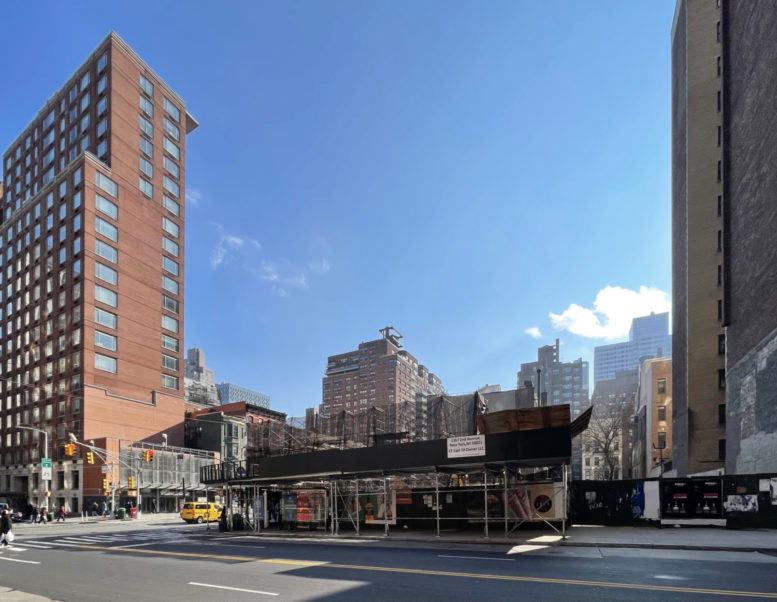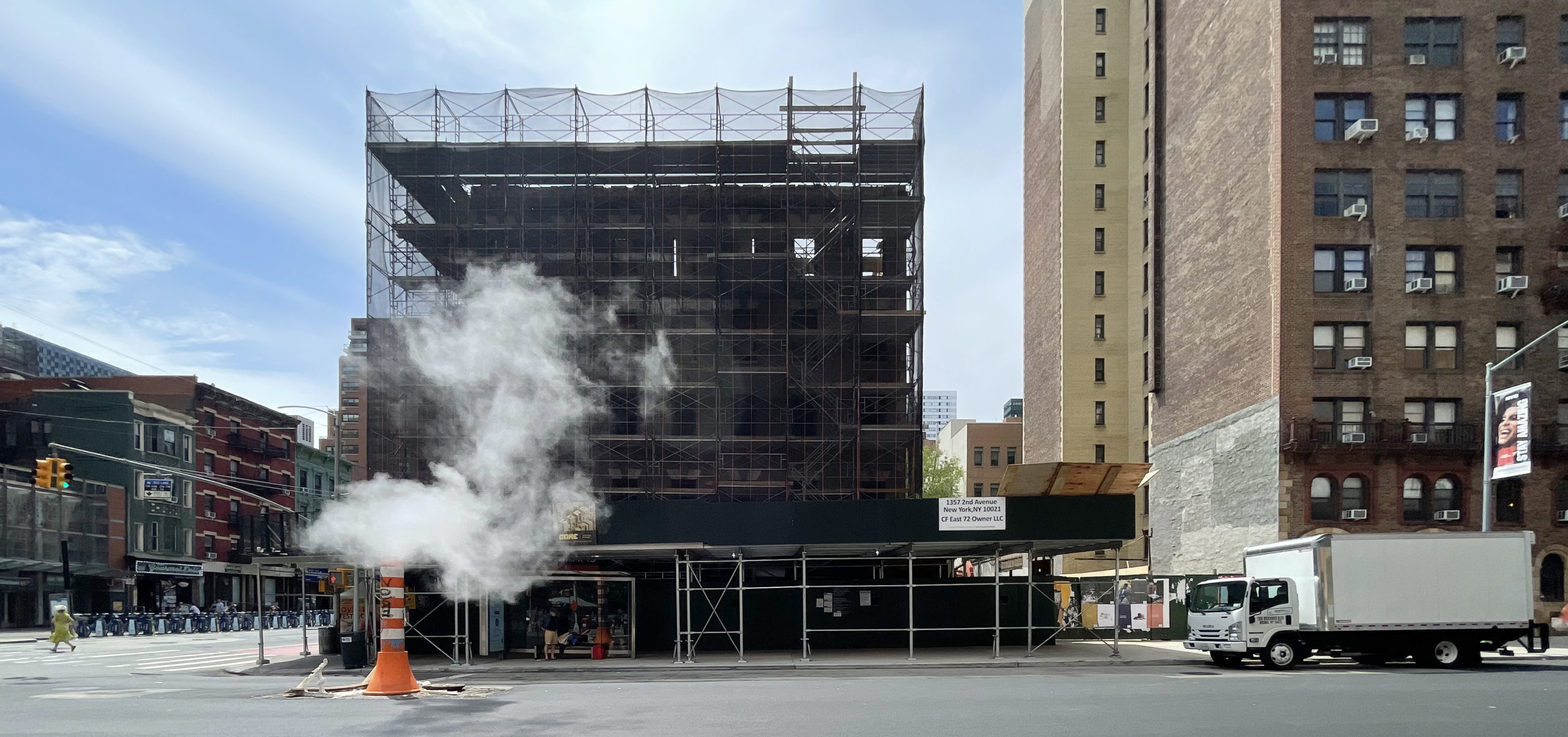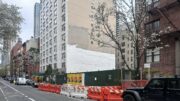Demolition is wrapping up at 1357 Second Avenue, the site of a 21-story residential building in the Lenox Hill section of Manhattan’s Upper East Side. Developed by The Chetrit Group, which purchased the property for $47.2 million in 2018, the 230-foot-tall structure will yield 54 apartments spread across 150,000 square feet and 5,700 square feet of commercial space. The development also includes a four-story, 40-foot-tall annex that will yield an additional inventory of affordable housing units. CF East 72 Owner LLC is the owner and RIG Kingland Services is the general contractor for the project, which is located at the corner of Second Avenue and East 72nd Street.
The four five-story apartment buildings that previously occupied the site have been razed down to street level, and an excavator is currently working to clear the remaining debris behind scaffolding and sidewalk fencing. The project also required the demolition of a small church along East 72nd Street, as well as two four-story brownstones on East 71st where the affordable housing annex will eventually stand.
The below photos detail the state of demolition in August 2022, when the four main occupants of the plot were in the process of being dismantled.
The following Google Street View images from June 2022 show the state of the property just before demolition began on the apartment buildings.
The below map details the footprint of 1357 Second Avenue, with its narrow annex reaching East 71st Street.
The site is located directly across from the 72nd Street subway station, serviced by the Q train. This proximity places 1357 Second Avenue within a Special Transit Land Use District, giving the MTA the option to develop a portion of the site for a new station entrance or other transit improvements. The property is also located near the 6 train at the 68th Street-Hunter College station.
No architect, renderings, or construction timeline have been revealed for the project yet.
Subscribe to YIMBY’s daily e-mail
Follow YIMBYgram for real-time photo updates
Like YIMBY on Facebook
Follow YIMBY’s Twitter for the latest in YIMBYnews
















Of course the best looking buildings get razed while the ugly ones remain.
Glad you are showing what was. Not a great building, for sure, but that area appears to be becoming less vibrant
I wonder what’s the time frame of area landfills getting FULL with so many buildings getting demolished?!
Follow-up…
As someone who isn’t a NYC resident, I have followed this blog for a couple years due my interest in architecture (both historic and new), but wonder each time a “yimbie” gets excited about another “BladeRunner” mega-tall reaching the sky, are anybody them at all concerned about the tons and tons of debris from these demolitions?
How all this waste… concrete, bricks, architectural details, steel, asbestos, etc. is impacting the environment longer than our lifetimes!
Or DON’T they care?
I’m not advocating for reusable building materials going to waste but I think you are seriously underestimating the land available for fill material in this vast country of ours. Also in many cases I believe bricks are purchased by third party reclaimer companies and you should know that nearly every magnetic and non-magnetic piece of metal in a building demo is sold as a scrap contract. There’s actually a lot less landfill bound waste than you would imagine in a building tear down. Especially in a highly regulated city like NY that doesn’t allow heavy machinery and crawlers to just push a building over and scoop it up in huge piles into the back of a dump truck while toxic dust blows everywhere. Most of these buildings are meticulously deconstructed brick by brick over weeks – hence the black shrouds of death.
I should also mention it’s nothing new. People have been dumping concrete debris from buildings and roads onto eroding riverbanks and useless gullies and along railroad embankments and to extend buildable landmass into a body of water and on and on for ages. Probably since the beginning of civilization if we’re talking dates.
concrete, brick, stone… debris
Answer… Probably not enough to cover up all the toxic batteries that are starting to expire from EV’s, smartpones and PC’s.
I want to see the remaining debris behind scaffolding and sidewalk fencing, according to a set of razes for the newer than previously structured. In the meantime I would like to stop at the state of the property before demolition, though I can’t see demolition man but I’m keeping tune on an updated: Thanks to Michael Young.
Any idea how many housing units already existed? 54 units does not seem like much of a net gain.
nyc zoning map says 128. :/
That’s a significant improvement and a much better and efficient use of the same plot of land. This should be an example of how not all developments are generalized the way Guesser depicts them in his mind.
Tyler
How the FK does tearing down a perfectly built century old building(which should have been landmarked), when it can easily be readapted/reused in the new building make this crappy development for the super rich a much better and efficient use of the land? BTW I forgot to mention that it’s being built for the super rich when we have a housing crisis in NYC for low and middle income people.
Please explain that one?
I’m anxiously awaiting your answer
Again, stop shouting and using profanity, it’s not that hard to do…
And “perfect” is a stretch. Though not every building, old or new, may be perfect, it’s less likely for old construction to not deal with the issues of old bones, pest complaints, fire hazards (like that gas explosion in an old tenement in the lower east side in 2015) and over a century of wear and tear. I’d be hard pressed to find a landlord that can afford to find enough money in this economy to significantly fix up a building. But new construction can also be shoddy if not properly built with all parts of the building aligning. In the end, I’d still choose new construction which is typically much safer, more energy-efficient, and has better living standards.
And yeah these will likely be condo units in the millions, but I doubt a billionaire, usually classified as “super rich” than just “rich,” would be moving or buying here, whereas they can easily afford and likely choose something on Billionaire’s Row where lots of other billionaires are attracted to buy properties.
Super rich people wouldn’t live in affordable housing units though.
And are you really suggesting that those old buildings were really worthy of landmark status? Would the city grind to a halt without those old walk-ups existing in our every day lives and our a memorial plaque that says what once stood there? I doubt there is any compelling argument to be made for that case, nor match other more significant landmarked icons like Grand Central Terminal. There is a plethora of other more beautiful structures that have been saved and restored than what was torn down.
If you decide to be a landlord and manage to buy a 100+ year old walk-up and see how hard it is right now to fork up a seven-figure renovation budget, then be my guest and come back to when you deal with that and realize why it makes more economical sense to allow developers to build new.
tyler ,
Of course you didn’t answer my question , maybe because you don’t have an answer? I’ll repeat it.
How does tearing down perfectly built century old buildings (which should have been landmarked), when it can easily be readapted/reused in the new building make this crappy development for the super rich a much better and efficient use of the land?
Can’t wait to hear your explanation.
“And are you really suggesting that those old buildings were really worthy of landmark status? ”
Yes I am.
“Would the city grind to a halt without those old walk-ups existing in our every day lives and our a memorial plaque that says what once stood there?” Here’s my answer.
Would the city grind to a halt if this crappy development wasn’t being built for the super rich who will
pay , 54 units at 5 million average per unit is $220 million, So most likely developer wants $7 to 8 million a unit ? Would we grind to a halt?
“If you decide to be a landlord and manage to buy a 100+ year old walk-up and see how hard it is right now to fork up a seven-figure renovation budget.”
You’re kidding me right? First of all, It’s four five-story apartment buildings, not one that previously occupied the site and second do you really honestly believe that the Chetrit Group, which purchased the property for $47.2 million in 2018, would have any trouble spending more money?
Do you?
I didn’t ask if the new developers can afford to spend, I asked from the point of view from the former building landlords that were likely in debt and falling behind on maintenance
Tyler you still didn’t answer my question about your comment because you can’t!
How does tearing down perfectly built century old buildings (which should have been landmarked), when it can easily be readapted/reused in the new building make this crappy development for the super rich a much better and efficient use of the land?
Still waiting.
“I asked from the point of view from the former building landlords that were likely in debt and falling behind on maintenance”
How can you state this when you can’t prove it true? It’s all conjecture on your part to back up your Yimby opinion.
54 units at 5 million average per unit is $220 million . So most likely developer wants $7 to 8 million a unit for $378 million to $432 million. 150,000 feet at $3000 per foot is $450 million .
With rates higher not sure if this will produce a profit unless they are selling to the Saudi’s , lol..
Tmrates are higher now.
There probably is ground retail as well? But no chance they’ll get 3k a foot there…